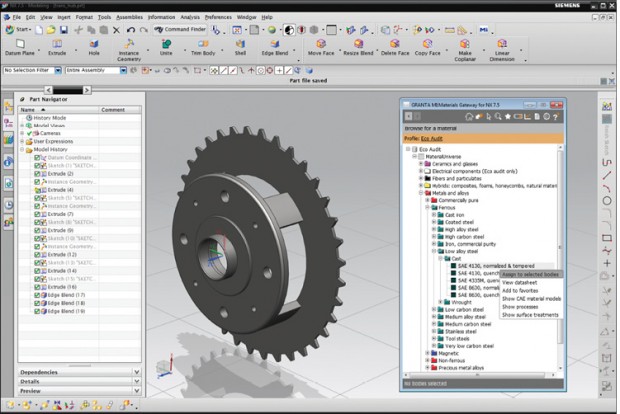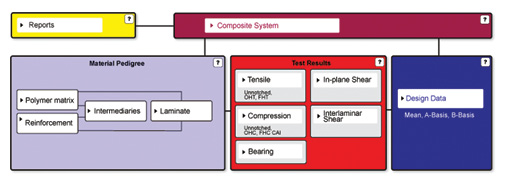
A key AutoMatIC goal is to provide a standard view of materials across all stages of design and engineering. This screenshot showcases Granta’s MI:Materials Gateway for Siemens NX — a window into a company’s materials specifications directly within CAD. Image courtesy of Granta Design.
April 1, 2015
 A key AutoMatIC goal is to provide a standard view of materials across all stages of design and engineering. This screenshot showcases Granta’s MI:Materials Gateway for Siemens NX — a window into a company’s materials specifications directly within CAD. Image courtesy of Granta Design.
A key AutoMatIC goal is to provide a standard view of materials across all stages of design and engineering. This screenshot showcases Granta’s MI:Materials Gateway for Siemens NX — a window into a company’s materials specifications directly within CAD. Image courtesy of Granta Design.The steel and auto industries have long been inextricably tied. Pittsburgh counts Detroit among its most prolific customers. But with regulators calling for higher emissions standards in the coming years, car makers have been steadily adding alternative materials like carbon fiber composites and aluminum to the mix, loosening their ties to steel and ramping up materials programs as part of competitive business strategy.
The heightened focus on materials has opened the door to the Automotive Material Intelligence Consortium (AutoMatIC), a new collaborative effort tasked with helping auto OEMs (original equipment manufacturers) and suppliers make the most out of materials information and develop best practices. Spearheaded by materials information expert Granta Design, along with five automotive industry founding members, the AutoMatIC takes a page from similar efforts in the aerospace sector to improve how materials data is organized and managed. By creating standard methods of storing and sharing materials-related data, the goal is to open up new avenues for automotive design engineers who have limited experience with the properties and behaviors of non-traditional materials.
“The auto industry has been using different materials for a long time, but they’ve never really had the strategic importance that they’ve gotten over the past few years,” says Dan Williams, product management and marketing manager at Granta Design, which markets Granta MI, a materials information management system.
A look at some of the industry’s marquee projects illustrates how far car companies have come melding alternative materials into next-generation vehicles. Ford Motor Co., for example, made headlines with the redesign of its best-selling F150 pick-up truck, which features an all-aluminum body to achieve a weight savings of 700 pounds over its all-steel predecessor. Still in the experimental stages is the multi-material lightweight vehicle (MMLV), a project between Ford and Magna International Inc. to create a concept vehicle that employs advanced materials in different areas of the car to achieve a nearly 25% weight reduction compared to the 2013 Ford Fusion, the production vehicle upon which it is based. There’s also BMW, which has made significant investments in carbon fiber materials that will be used to produce its i3 and i8 boutique electric vehicles.
“CEOs of auto companies are now talking about materials strategies and what the plan is for the right materials mix,” Williams says. “With materials programs now taken so seriously, the time is right for a consortium that can help simplify and standardize best practices.”
Taking a Page from Aerospace
AutoMatIC, announced last April, aims to do just that. In addition to Granta, founding members include such heavyweights as General Motors, Honeywell Turbo Technology, Jaguar Land Rover, KSPG AG and PSA Peugeot Citroën. The consortium was modeled after the Material Data Management Consortium (MDMC), a similar Granta-led effort to develop and apply software to manage mission-critical materials data for the aerospace, defense and energy sectors.
Since its inception in 2002, the MDMC has helped member organizations improve productivity in materials engineering, avoid data loss and duplication of tests and reduce risk in the engineering and design process, Williams says. The ability to routinely control, analyze and apply materials data has helped companies like NASA, Boeing, and Rolls-Royce save time throughout their complex design cycles while improving compliance with critical regulations. With AutoMatIC, Granta hopes to repeat those benefits in the automotive space, which have translated into millions in savings as well as milestones for participating MDMC companies.
 Providing materials information to support virtual product development is a major AutoMatIC initiative. This image shows a three-way interaction between the materials database (GRANTA MI), the pre-processor (HyperMesh) and the solver (LS-DYNA). Image courtesy of Granta Design.
Providing materials information to support virtual product development is a major AutoMatIC initiative. This image shows a three-way interaction between the materials database (GRANTA MI), the pre-processor (HyperMesh) and the solver (LS-DYNA). Image courtesy of Granta Design.“We have a phenomenally successful model in the aerospace industry and it’s helping us define how this should be done,” Williams says. “What we’re doing with [AutoMatIC] is tailoring the technology to the needs of the automotive industry. Different industries rely on different kinds of simulation and do things in a different way.”
Similar to aerospace, the automotive industry relies on a range of exhaustive simulation studies as part of the development effort to explore how vehicle designs hold up under various conditions, including crash tests, reliability and the impact of noise, vibration and harshness on the overall ride. The simulation’s complexity calls for a keen understanding of materials’ characteristics and behavior. Without best practices for sharing and storing materials-related data, there are little guarantees that engineers will have ready access to that data to make informed design decisions, Williams says.
“It’s more than just a few numbers about how strong and stiff a material is, there needs to be lots of data to understand how a particular material behaves when crashed at high speed or when it’s vibrating next to an engine,” says Williams. “This is complicated information, and the data becomes very valuable because there is an awful lot of money being invested in simulation. If the data you put into the simulation is bad, what you get out becomes bad as well.”
While this information has been available in organizations, to some degree, it’s been scattered and ad hoc. Williams says this is the data tucked away in a siloed crash test database or in a banned substance list that only the procurement department can access. Oftentimes, he said, the information isn’t even in a formal database — it could be in spreadsheets or filing cabinets or even in the head of some guy who’s retiring next month. “The data is scattered and tends to be in pockets,” he says. “We are trying to create standards to join up all these communities.”
The AutoMatIC Agenda
While it’s only hosted one meeting (with another slated for later this month) AutoMatIC has a few key objectives. The first is to create templates for how composite data is stored and managed, which would facilitate the exchange of key design information and be much easier for automotive industry players than designing a schema on their own, Williams says. From there, the consortium is tasked with sharing expertise and best practices.
One thing Williams is quick to point out is that the consortium members do not share their materials data — only the schema, templates and best practices related to storing such data so intellectual property remains their own. “What we’re doing is agreeing to how this data should be shared, we’re not encouraging them to share competitive or sensitive data,” he says.
The data sharing standards and best practices would transcend multiple layers, from the data security and collaboration best practices related to IT infrastructure, all the way through how to store and specify materials information related to composites, fabrics, lightweight alloys, and welding and joints. Standardizing how this information is managed and stored facilitates integration with other core design software like simulation, PLM (product lifecycle management), CAD, etc., Williams says.
 This high-level schematic of a composites’ “schema,” developed by the aerospace industry-focused Materials Data Management Consortium (MDMC), is akin to what AutoMatIC will develop to meet the materials data management priorities of the automotive industry. Image courtesy of Granta Design.
This high-level schematic of a composites’ “schema,” developed by the aerospace industry-focused Materials Data Management Consortium (MDMC), is akin to what AutoMatIC will develop to meet the materials data management priorities of the automotive industry. Image courtesy of Granta Design.Linking materials data to core CAD and CAE tools and gaining input to accelerate its own materials data management efforts are the primary reasons Jaguar Land Rover (JLR) is onboard with AutoMatIC, says Dr. Mark Blagdon, materials characterization technical specialist for the firm, which is a user of Granta’s MI materials information management platform.
“We need quicker and more robust distribution of the design data via tighter integration between Granta MI and our PLM system and CAE pre-processor,” Blagdon says. “This will be a common issue for other automotive OEMs so I hope we can use our collective voice to aid in prioritizing the development of these tools.”
While JLR has invested a lot of time and money into developing a materials management strategy around Granta MI, there is a sharp learning curve in understanding how to store data, Blagdon says. The hope is the consortium’s efforts can accelerate the process — for example, using the output from the “joining schema” workgroup to use as a base point for JLR’s own joint properties database.
“By sharing knowledge and collaborating on common database schema and tools with other members will assist in our return on that investment,” he says. “I have seen some excellent presentations by other members that has widened my understanding of how we could use the Granta MI tool to assist with JLR’s wider data management needs.”
AutoMatIC members don’t have to be Granta MI users, although currently all founding members do have materials management efforts underway using the software. Williams says automakers can still benefit from exposure to best practices for sharing materials data so they can reduce risk, streamline costs and make the smartest decisions possible about materials.
According to JLR’s Blagdon, there is too much at stake for automakers if they don’t address materials data management best practices. “The cost of us not using this data or using poor quality data in the design phase due to either poor distribution or poor translation of data from one format to another is a threat to the robust delivery of the vehicle programs,” he explains. “We need to develop ‘more great products faster,’ and a company wide materials database is key to supporting this aim.”
More Info:
Subscribe to our FREE magazine, FREE email newsletters or both!
About the Author
Beth Stackpole is a contributing editor to Digital Engineering. Send e-mail about this article to [email protected].
Follow DE





